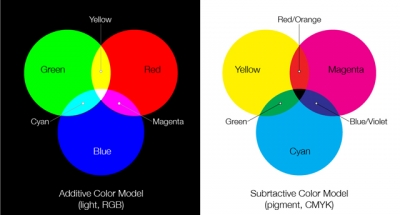
Sunlight is broadly made up of the three primary colours of light: blue, green and red. All colours can be made by different mixtures of the three. Pairs of primary colours produce secondary colours: magenta (blue and red), yellow (green and red), and cyan (green and blue). If secondary colours are paired, they produce the primary colours. Magenta and yellow make red, cyan and yellow make green, cyan and magenta make blue. Each of the six colours takes no part in making up the colours opposite to it in the charts. Blue and yellow are ‘opposites’, so are green and magenta, and red and cyan.
Negative and print
A colour film has three layers, each sensitive to one of the primary colours. When a photograph is taken, each layer records a primary colour but forms an image in dye of the opposite colour to the primary.
The negative is then printed by light in a darkroom on paper that contains similar colour-sensitive layers. When normal light passes through the blue wheel on the negative, the yellow dye blocks the blue rays but lets through the red and the green. The paper records the red and green cyan and magenta dyes (their ‘opposites’). When you look at the photograph the combination of cyan and magenta appears blue. All the other colours are produced in the same way.
Picture Credit : Google

